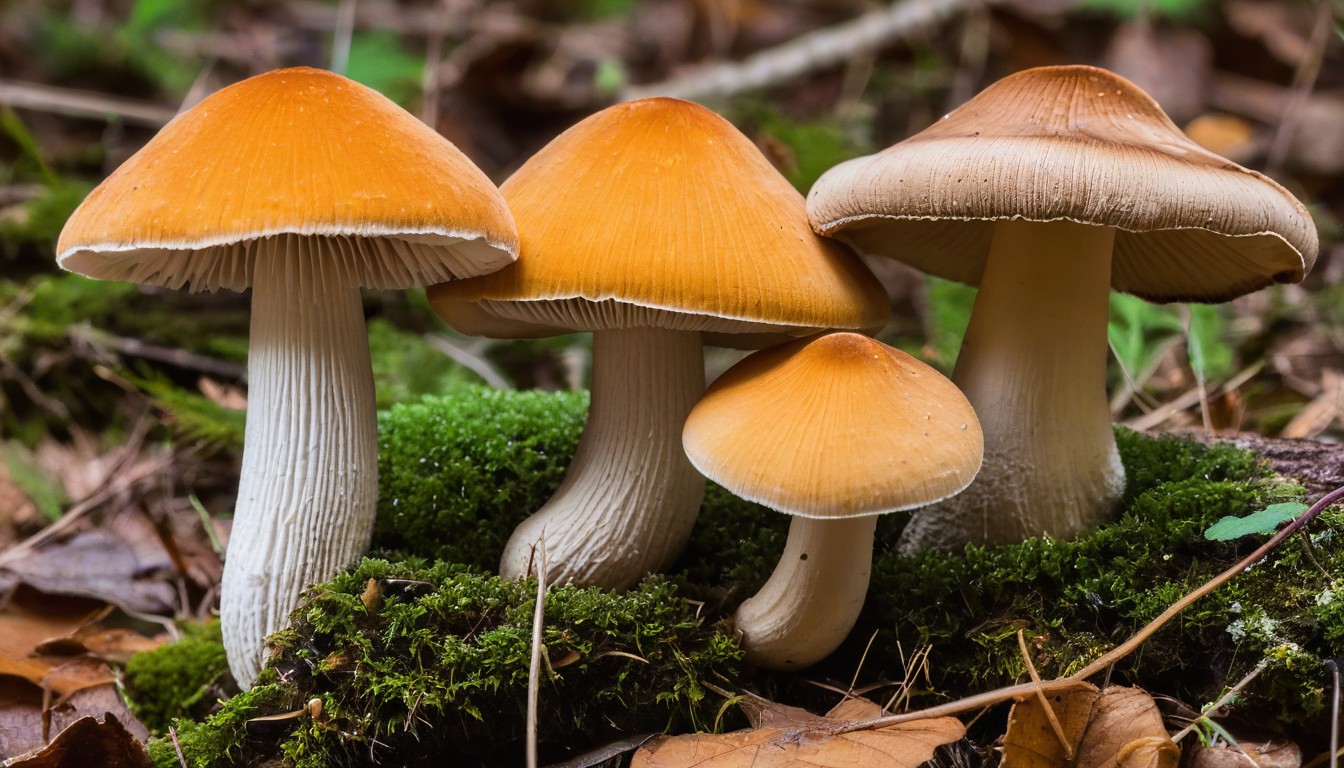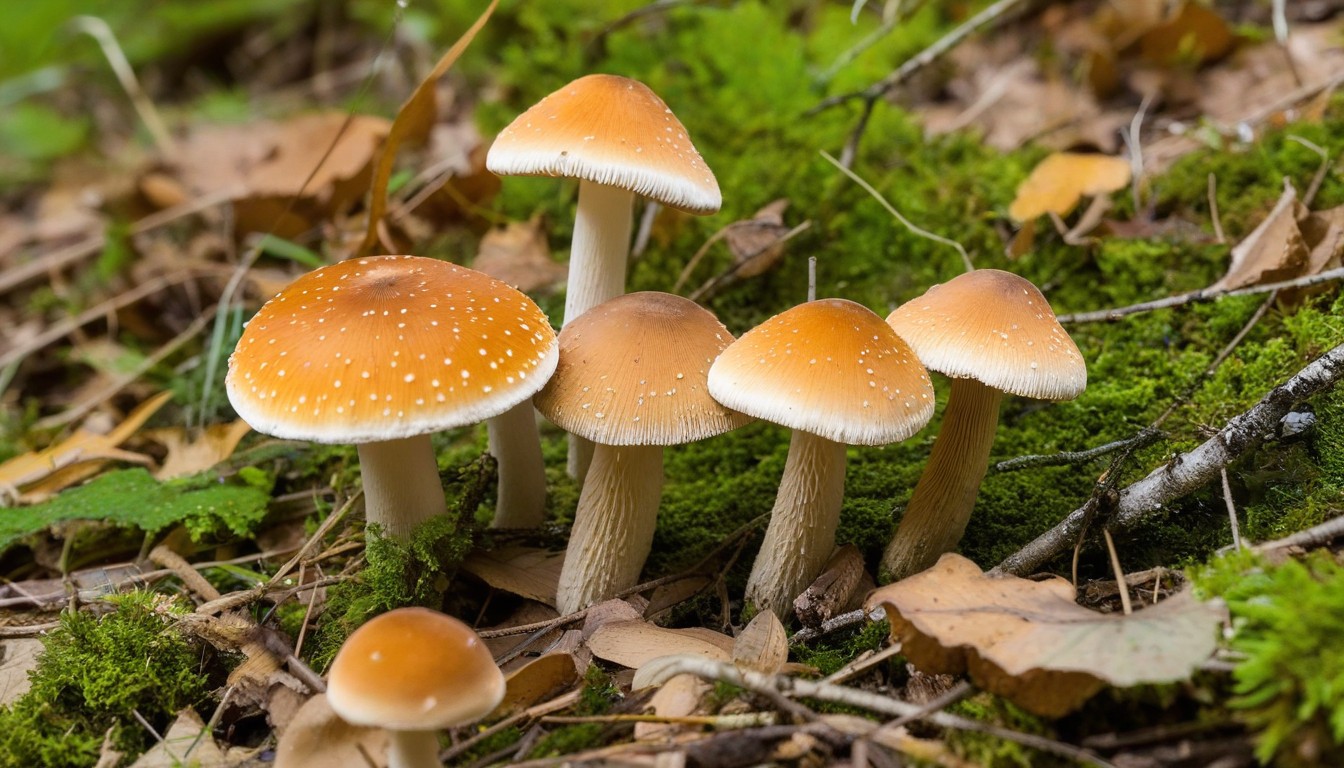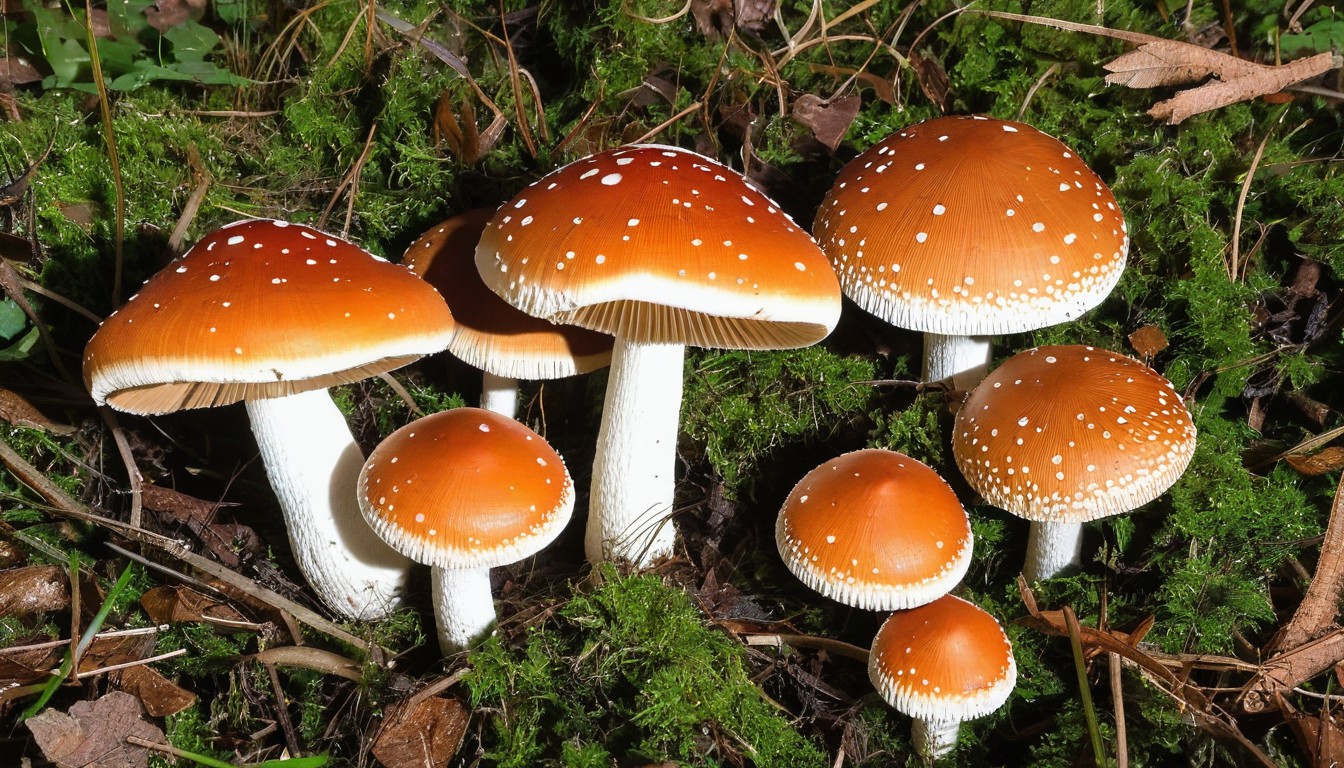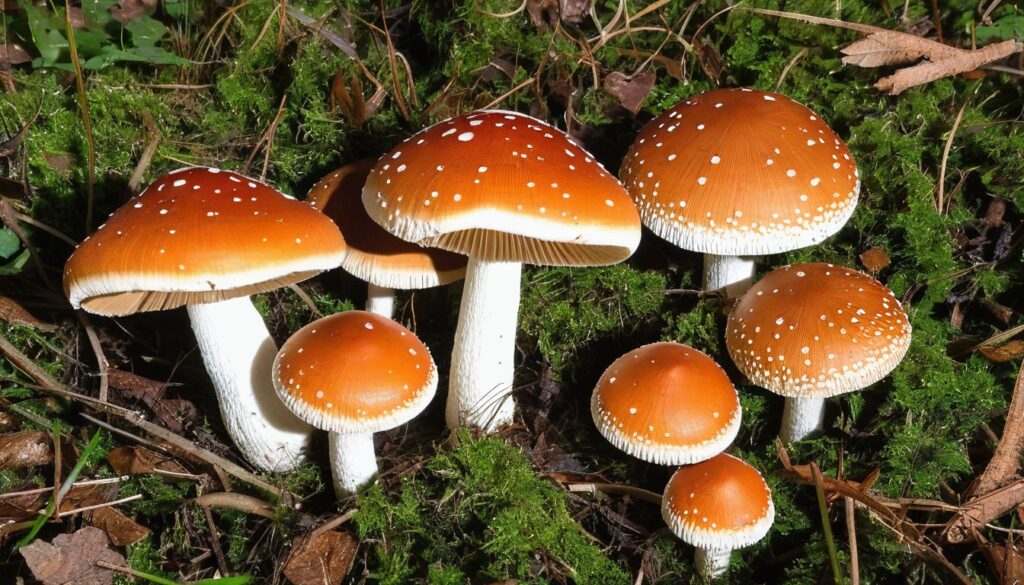Welcome to our comprehensive guide to the common mushrooms in Arkansas
. Arkansas is home to a diverse range of fungi species, and this guide will take you on a mycological journey through the fascinating world of mushrooms found in the state. Whether you’re a novice mushroom hunter or an experienced forager, this guide has something for everyone.
Key Takeaways:
- Arkansas is home to a diverse range of mushroom species.
- It’s important to know the regulations and guidelines for mushroom foraging in the state.
- Some mushrooms found in Arkansas are edible and can be safely consumed.
- There are toxic mushroom species in Arkansas that can cause harm if consumed.
- Mushrooms native to Arkansas have potential medicinal properties.
What Are Mushrooms?
When we hear the word mushrooms, we may think of common button or portobello mushrooms found in the grocery store. However, mushrooms are much more diverse than what we typically see on our plates. They belong to the kingdom Fungi, alongside molds and yeasts.
Mushrooms are the fruiting bodies of fungi. They grow from underground networks of thread-like structures called mycelium, which absorb nutrients from their surroundings. When conditions are right, the mycelium develops into mushrooms that release spores into the air. These spores can then germinate and grow into new mycelia, continuing the cycle.
From decomposition to disease control, mushrooms play a critical role in the ecosystem. They break down and recycle organic matter, which helps maintain soil health. Some species of mushrooms can also form symbiotic relationships with plants, aiding in their growth. Additionally, certain mushrooms have been found to have medicinal properties or nutritional benefits.
Arkansas Mushroom Hunting Regulations
Before setting off on your mushroom foraging adventure in Arkansas, it is essential to be aware of the state’s regulations and guidelines. These rules are in place to protect both the mushroom hunters and the environment. Failure to follow these regulations could result in fines or even criminal charges.
Arkansas Mushroom Hunting Permit
According to the Arkansas Game and Fish Commission, anyone hunting mushrooms on designated wildlife management areas (WMAs) must possess a valid hunting license, a Wildlife Management Area USER permit, and a $5 Annual General Use Mushroom Permit.
Where Mushroom Hunting Is Permitted
Mushroom hunting is allowed on state and federal public lands and private lands with permission from the landowner. However, you should be aware of areas where mushroom hunting is prohibited, such as the Ozark National Forest. It is recommended that you check with the appropriate agency for the most up-to-date information on where mushroom hunting is permitted.
Types of Mushrooms You Can Hunt In Arkansas
Most of the mushrooms found in Arkansas are edible and non-toxic. However, it is always important to be aware of the visual differences between edible and poisonous fungi. The most commonly hunted mushrooms in Arkansas include morel, puffball, chicken of the woods, and chanterelle. Hunting endangered or rare mushroom species is prohibited by the state.
Rules for Mushroom Hunting in Arkansas
When hunting for mushrooms in Arkansas, you must abide by these rules:
- Do not use rakes or other similar tools that can damage the forest floor or vegetation.
- Do not litter while mushroom hunting.
- Do not collect mushrooms in plastic bags that do not allow breathing, as this can cause them to spoil quickly.
- Respect the environment and avoid over-harvesting.
Edible Mushrooms in Arkansas

Arkansas is a haven for mushroom enthusiasts, both foragers, and foodies alike. Here are eight of the most common edible mushrooms found in the state:
|
Mushroom Name |
Description |
Edible Parts |
|---|---|---|
|
Morel |
Distinctive honeycomb-like cap and hollow stem |
Cap and stem |
|
Beech Mushroom |
Small, vase-shaped cap and white stem |
Cap and stem |
|
Hen of the Woods |
Cluster of fan-shaped, ruffled, smokey-gray caps |
Caps |
|
Oyster Mushroom |
Fan-shaped cap with a creamy-white to light-brown color |
Cap and stem |
|
Round, softball-sized mushrooms with smooth, white, or tan skin |
Flesh | |
|
Cauliflower Mushroom |
Irregular-shaped clusters of pale, wavy caps that resemble cauliflower |
Caps and stems |
|
Trumpet-shaped cap with a bright orange or yellowish color |
Cap and stem | |
|
Black Trumpet Mushroom |
Small, funnel-shaped cap with a blackish appearance |
Cap and stem |
The above-listed mushrooms have a unique flavor and aroma, making them a popular ingredient in dishes from around the world. From stir-fries to soups, salads to sauces, there are endless ways to enjoy these Arkansas delicacies.
If you are unsure about identifying any mushrooms, it’s always recommended to consult an expert to avoid any risk of consuming poisonous mushrooms. Remember to follow safe and ethical foraging practices while exploring the diverse fungal wonders of Arkansas!
Poisonous Mushrooms in Arkansas
While Arkansas is home to a variety of edible mushrooms, it’s important to be aware of the potentially harmful species that also exist. These poisonous mushrooms can cause serious health issues if ingested, so it’s crucial to know how to identify them.
Common Poisonous Mushrooms in Arkansas
|
Mushroom Name |
Description |
Effect |
|---|---|---|
|
Death Cap (Amanita phalloides) |
Small to medium-sized mushroom with a greenish-yellow cap. |
Can cause liver and kidney failure, leading to death. |
|
Galerina (Galerina marginata) |
Small, brown mushroom with a convex cap. |
Can cause severe liver damage, which may result in death. |
|
False Morel (Gyromitra species) |
Brain-shaped mushroom with ridges and wrinkles on the cap, usually reddish-brown in color. |
Can cause gastrointestinal issues, seizures, and even death. |
|
Jack-o’-Lantern Mushroom (Omphalotus illudens) |
Orange mushroom with gills that glow in the dark. |
Can cause severe cramps, vomiting, and diarrhea. |
Remember, this table isn’t exhaustive, and there are many other poisonous mushrooms that can be found in Arkansas. If you’re ever unsure whether a mushroom is safe to eat or not, it’s best to err on the side of caution and avoid consuming it altogether.
Even handling some poisonous mushrooms can cause skin irritation or other reactions, so it’s crucial to wear gloves and handle mushrooms with care. If you suspect you or someone else has ingested a poisonous mushroom, seek medical attention immediately.
Medicinal Mushrooms in Arkansas

Mushrooms have been used for their medicinal properties for centuries, and Arkansas is no exception. The state is home to several varieties of fungi that have been traditionally used for their healing benefits.
Reishi
Reishi mushrooms have been used in traditional Chinese medicine for thousands of years. They are known for their immune-boosting properties and are often used to improve overall health and wellbeing. In Arkansas, reishi mushrooms can be found growing on dead or dying hardwood trees.
|
Health Benefits of Reishi Mushrooms |
|---|
|
Boosts immune system |
|
Promotes healthy heart function |
|
Reduces inflammation |
|
Improves sleep |
Chaga
Chaga mushrooms are another species commonly found in Arkansas. They are known for their antioxidant properties and have been used to treat various ailments, including digestive issues and skin problems. Chaga mushrooms can be found growing on birch trees in the state.
|
Health Benefits of Chaga Mushrooms |
|---|
|
High in antioxidants |
|
Boosts immune system |
|
Reduces inflammation |
|
Lowers cholesterol |
Lions Mane
Lions Mane mushrooms are known for their neuroprotective properties and have been studied for their potential in treating neurological disorders. They can be found growing on hardwood trees, including oak and maple, in Arkansas.
|
Health Benefits of Lions Mane Mushrooms |
|---|
|
May improve cognitive function |
|
May help protect against neurological disorders |
|
May reduce inflammation |
|
May reduce symptoms of anxiety and depression |
These are just a few examples of the medicinal mushrooms found in Arkansas. Before consuming any mushrooms, it is important to properly identify them and consult with a healthcare professional.
Rare and Protected Mushrooms in Arkansas

Arkansas is home to a variety of unique and rare mushroom species that are classified as endangered or threatened. These mushrooms play a crucial role in the state’s ecosystems, and their protection is of utmost importance.
|
Mushroom |
Conservation Status |
Interesting Facts |
|---|---|---|
|
Arkansas truffle |
Endangered |
Only found in a few areas of the Ouachita and Ozark Mountains. |
|
Prairie Dawn truffle |
Endangered |
Named after a line in the movie “Little Miss Sunshine.” |
|
Cumberland Plateau salamander truffle |
Threatened |
Only found in the Cumberland Plateau region of Arkansas. |
In order to preserve these rare and protected mushrooms, it is important for mushroom hunters and enthusiasts to be aware of their existence and to avoid disturbing or damaging their habitats. If you come across any of these species in their natural environment, please report your findings to the Arkansas Game and Fish Commission. Together, we can help ensure these unique fungal wonders will continue to thrive in Arkansas.
Mushrooms in Arkansas Forests

Arkansas is home to an incredible variety of mushrooms that flourish in its diverse forests.
The state’s ecosystems – which include mixed hardwood, pine and deciduous forests – create the ideal conditions for mushrooms to grow.
Whether you’re hiking trails in the Ozarks or exploring the Ouachita National Forest, you’re bound to encounter a variety of mushrooms throughout your journey.
Some of the most common species found in Arkansas forests include:
|
Mushroom |
Description |
|---|---|
|
Chanterelle |
A trumpet-shaped mushroom with a fruity aroma and delicate texture. Known for its vibrant orange color and earthy flavor. |
|
Morel |
A spongy, cone-shaped mushroom with a honeycomb-like appearance. Known for its nutty, meaty flavor and prized by chefs for its unique taste and texture. |
|
Lion’s Mane |
A shaggy-looking mushroom with a meaty texture and a flavor that’s often described as similar to lobster or crab. Known for its health benefits and medicinal properties. |
As always, it’s essential to exercise caution when foraging for mushrooms in the wild. Some species can be toxic or poisonous and may resemble edible mushrooms, so it’s crucial to identify your finds and know which are safe to consume.
With its vast range of habitats, Arkansas is a mycologist’s paradise. So why not grab your basket and go on a mushroom hunt today?
Popular Mushroom Recipes from Arkansas
Looking to elevate your culinary skills and try something new? Arkansas is home to a variety of mushrooms that add unique flavor and texture to any dish. Whether you are a seasoned chef or a beginner in the kitchen, these popular mushroom recipes from Arkansas are sure to impress your taste buds.
Mushroom and Goat Cheese Crostini
These crostinis are the perfect appetizer for any occasion. Begin by slicing the mushrooms and sautéing them over medium-high heat for about 5 minutes. Add garlic, salt, and pepper to taste. Spread goat cheese on toasted baguette slices and top with the sautéed mushrooms. Garnish with fresh thyme and serve.
Mushroom Gravy
This savory mushroom gravy is the perfect addition to your Thanksgiving feast. Begin by cooking chopped onions and garlic in butter until softened. Add sliced mushrooms and cook until they release their moisture. Stir in flour and cook for 1-2 minutes. Gradually add broth while stirring constantly. Bring to a boil and then reduce heat, stirring occasionally for about 10 minutes. Serve over mashed potatoes or turkey for a delicious Thanksgiving side.
Portobello Mushroom Burger
Trade in your traditional beef patty for a juicy portobello mushroom burger. Begin by marinating portobello mushroom caps in a mixture of balsamic vinegar, olive oil, garlic, salt, and pepper for at least an hour. Grill or sauté the mushrooms for about 5 minutes on each side. Serve on a bun with your favorite toppings such as lettuce, tomato, and mayo.
|
Dish |
Ingredients |
Instructions |
|---|---|---|
|
Mushroom and Goat Cheese Crostini |
Sliced mushrooms, garlic, salt, pepper, goat cheese, toasted baguette slices, fresh thyme |
Sauté mushrooms with garlic, salt, and pepper. Spread goat cheese on toasted bread slices. Top with mushrooms and garnish with fresh thyme. |
|
Mushroom Gravy |
Chopped onions, garlic, butter, sliced mushrooms, flour, broth |
Cook onions and garlic in butter. Add mushrooms and cook until they release their moisture. Stir in flour. Gradually add broth and stir consistently until boiling. Reduce heat and stir occasionally for about 10 minutes. |
|
Portobello Mushroom Burger |
Portobello mushroom caps, balsamic vinegar, olive oil, garlic, salt, pepper, burger bun, lettuce, tomato, mayo |
Marinate mushroom caps in vinegar, oil, garlic, salt, and pepper for at least an hour. Grill or sauté mushrooms for 5 minutes on each side. Serve on a bun with toppings. |
Conclusion
As you can see, Arkansas is home to a diverse range of mushrooms. From edible and medicinal to rare and protected, there is no shortage of fascination when it comes to exploring these fungi. Remember to always exercise caution when foraging, familiarize yourself with the regulations and guidelines, and avoid consuming any mushrooms that you’re unsure about.
By following the tips and advice laid out in this guide, you can start your own mycological adventure today. Whether you’re a seasoned forager or a curious novice, there is always something new to discover in the world of Arkansas mushrooms. So, put on your boots and grab your basket, and get ready to experience the wonders of these fungal treasures.
FAQ
What are common mushrooms in Arkansas?
Common mushrooms found in Arkansas include the morel, chanterelle, oyster mushroom, and chicken of the woods.
What are mushrooms?
Mushrooms are the fruiting bodies of certain fungi that grow from underground networks called mycelium. They serve various ecological roles and can be edible or poisonous.
What are the regulations for mushroom hunting in Arkansas?
Before venturing into mushroom hunting in Arkansas, it is crucial to be familiar with the regulations and guidelines set by the state. These include obtaining a permit, following specific collection limits, and respecting private property rights.
Which edible mushrooms can be found in Arkansas?
Some edible mushrooms commonly found in Arkansas include the morel, oyster mushroom, chanterelle, and hen of the woods. However, it is essential to have expert knowledge or guidance to identify and forage edible mushrooms safely.
Which mushrooms are poisonous in Arkansas?
Poisonous mushrooms in Arkansas include the deadly galerina, Amanita species such as the destroying angel and death cap, and the false morel. It is crucial to avoid consuming any wild mushrooms without expert identification.
Are there medicinal mushrooms in Arkansas?
Yes, Arkansas is home to several medicinal mushrooms such as the turkey tail, reishi, and lion’s mane. These mushrooms have traditional and modern uses in herbal medicine and may support immune function, cognitive health, and overall well-being.
What rare and protected mushrooms can be found in Arkansas?
Arkansas is home to rare and protected mushroom species such as the Ozark truffle and the Arkansas pyramid. These mushrooms are classified as endangered or threatened and require conservation efforts to preserve their populations.
Where can mushrooms be found in Arkansas forests?
Mushrooms can be found in various habitats within Arkansas’s forests, including hardwood forests, mixed pine and hardwood forests, and bottomland hardwood forests. Look for them around decaying logs, tree roots, and forest floors rich in organic matter.
What are some popular mushroom recipes from Arkansas?
Popular mushroom recipes from Arkansas include mushroom risotto, stuffed mushrooms, mushroom gravy, and mushroom and Swiss cheeseburgers. These recipes showcase the rich flavors and versatility of mushrooms in local cuisine.

